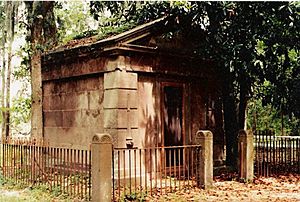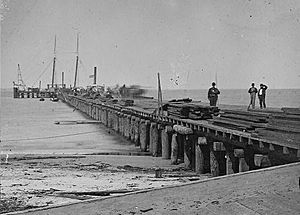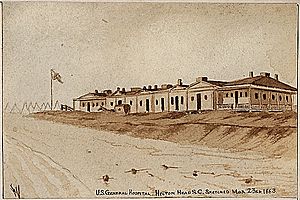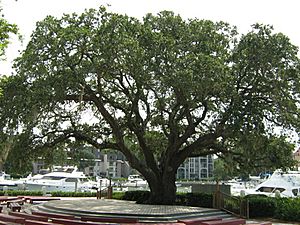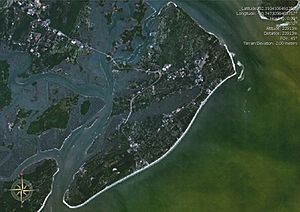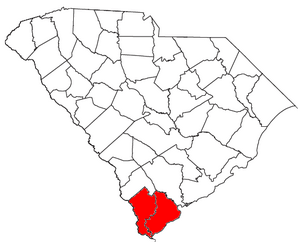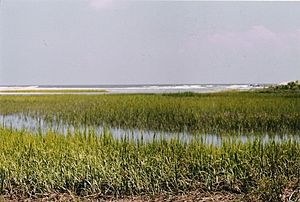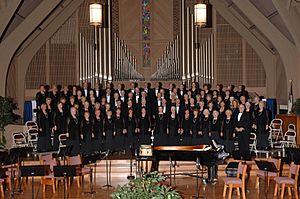Hilton Head Island, South Carolina facts for kids
Quick facts for kids
Hilton Head Island
|
||
|---|---|---|

Harbour Town Marina in Sea Pines Resort with the Harbour Town Lighthouse
|
||
|
||
| Nickname(s):
Hilton Head and HHI
|
||

Location of Hilton Head Island in Beaufort County and South Carolina
|
||
| Country | United States | |
| State | South Carolina | |
| County | Beaufort | |
| Incorporated (town) | 1983 | |
| Area | ||
| • Town | 69.13 sq mi (179.05 km2) | |
| • Land | 41.36 sq mi (107.11 km2) | |
| • Water | 27.78 sq mi (71.94 km2) 40.17% | |
| Elevation | 10 ft (3 m) | |
| Population
(2010)
|
||
| • Town | 37,099 | |
| • Estimate
(2019)
|
39,861 | |
| • Density | 963.83/sq mi (372.14/km2) | |
| • Metro | 187,010 (US: 211th) | |
| Time zone | UTC−5 (EST) | |
| • Summer (DST) | UTC−4 (EDT) | |
| ZIP code |
29925, 29926, 29928
|
|
| Area code(s) | 843 | |
| FIPS code | 45-34045 | |
| GNIS feature ID | 1246002 | |
Hilton Head Island, sometimes referred to as simply Hilton Head, is a Lowcountry resort town and barrier island in Beaufort County, South Carolina, United States. It is 20 miles (32 km) northeast of Savannah, Georgia, and 95 miles (153 km) southwest of Charleston. The island is named after Captain William Hilton, who in 1663 identified a headland near the entrance to Port Royal Sound, which mapmakers named "Hilton's Headland." The island features 12 miles (19 km) of beachfront on the Atlantic Ocean and is a popular vacation destination. In 2004, an estimated 2.25 million visitors infused more than $1.5 billion into the local economy. The year-round population was 37,099 at the 2010 census, although during the peak of summer vacation season the population can swell to 150,000. Over the past decade, the island's population growth rate was 32%. Hilton Head Island is a primary city within the Hilton Head Island-Bluffton-Beaufort metropolitan area, which had an estimated population of 207,413 in 2015.
The island has a rich history that started with seasonal occupation by Native Americans thousands of years ago and continued with European exploration and the Sea Island Cotton trade. It became an important base of operations for the Union blockade of the Southern ports during the Civil War. Once the island fell to Union troops, hundreds of ex-slaves flocked to Hilton Head, which is still home to many of their descendants, who are known as the Gullah (or Geechee). They have managed to hold on to much of their ethnic and cultural identity.
The Town of Hilton Head Island incorporated as a municipality in 1983 and is well known for its eco-friendly development. The town's Natural Resources Division enforces the Land Management Ordinance which minimizes the impact of development and governs the style of buildings and how they are situated amongst existing trees. As a result, Hilton Head Island enjoys an unusual amount of tree cover relative to the amount of development. Approximately 70% of the island, including most of the tourist areas, is located inside gated communities. However, the town maintains several public beach access points, including one for the exclusive use of town residents, who have approved several multimillion-dollar land-buying bond referendums to control commercial growth.
Hilton Head Island offers an unusual number of cultural opportunities for a community its size, including plays at the Arts Center of Coastal Carolina, the 120-member full chorus of the Hilton Head Choral Society, the Hilton Head Symphony Orchestra, an annual outdoor, tented wine tasting event on the east coast, and several other annual community festivals. It also hosts the RBC Heritage, a PGA Tour tournament played on the Harbour Town Golf Links in Sea Pines Resort.
Contents
History
New World discovery
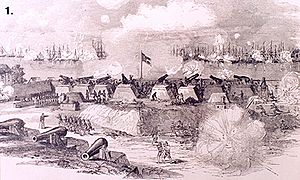
The Sea Pines shell ring can be seen near the east entrance to the Sea Pines Forest Preserve. The ring, one of only 20 in existence, is 150 feet (46 m) in diameter and is believed to be over 4,000 years old. Archeologists believe that the ring was a refuse heap, created by Indians who lived in the interior of the ring, which was kept clear and used as a common area. Two other shell rings on Hilton Head were destroyed when the shells were removed and used to make tabby for roads and buildings. The Green's Shell Enclosure, Sea Pines, and Skull Creek shell rings are listed in the National Register of Historic Places and are protected by law.
Since the beginning of recorded history in the New World, the waters around Hilton Head Island have been known, occupied and fought for in turn by the English, Spanish, French, and Scots.
A Spanish expedition led by Francisco Cordillo explored the area in 1521, initiating European contact with local tribes. In 1663, Captain William Hilton sailed on the Adventure from Barbados to explore lands granted by King Charles II of England to the eight Lords Proprietor. In his travels, he identified a headland near the entrance to Port Royal Sound. He named it "Hilton's Head" after himself. He stayed for several days, making note of the trees, crops, "sweet water", and "clear sweet air".
17th to 19th centuries

In 1698, Hilton Head Island was granted as part of a barony to John Bayley of Ballingclough, County of Tipperary, Kingdom of Ireland. Another John Bayley, son of the first, appointed Alexander Trench as the island's first retail agent. For a time, Hilton Head was known as Trench's Island. In 1729, Trench sold some land to John Gascoine which Gascoine named "John's Island" after himself. The land later came to be known as Jenkin's Island after another owner.
In the mid-1740s, the South Carolina provincial half-galley Beaufort was stationed in a cove at the southern tip of Hilton Head to guard against intrusions by the Spanish of St. Augustine. The point and cove are named after Captain David Cutler Braddock, commander of the Beaufort. Captain Braddock was a mariner and privateer of note in Colonial times. Earlier, he had been placed in command of the Georgia schooner Norfolk by James Oglethorpe, founder of Georgia, and helped chase the Spanish back to St. Augustine after their failed 1742 invasion of St. Simons Island. After relocating to Savannah in 1746, he served two terms in the Georgia Commons House of Assembly while earning a living as a highly active privateer. He drew a well-known chart of the Florida Keys while on a privateering venture in 1756. The chart is in the Library of Congress.
In 1788, a small Episcopal church called the Zion Chapel of Ease was constructed for plantation owners. The chapel's old cemetery, located near the corner of William Hilton Parkway and Mathews Drive (Folly Field), is all that remains. Charles Davant, a prominent island planter during the Revolutionary War, is buried there. Davant was shot by Captain Martinangel of Daufuskie Island in 1781. This location is also home to the oldest intact structure on Hilton Head Island, the Baynard Mausoleum, which was built in 1846.
William Elliott II of Myrtle Bank Plantation grew the first crop of Sea Island Cotton in South Carolina on Hilton Head Island in 1790.
During the Civil War, Fort Walker was a Confederate fort in what is now Port Royal Plantation. The fort was a station for Confederate troops, and its guns helped protect the 2-mile wide (3 km) entrance to Port Royal Sound, which is fed by two slow-moving and navigable rivers, the Broad River and the Beaufort River. It was vital to the Sea Island Cotton trade and the southern economy. On October 29, 1861, the largest fleet ever assembled in North America moved south to seize it. In the Battle of Port Royal, the fort came under attack by the U.S. Navy, and on November 7, 1861, it fell to over 12,000 Union troops. The fort was renamed Fort Welles, in honor of Gideon Welles, the Secretary of the Navy.
Hilton Head Island had tremendous significance in the Civil War and became an important base of operations for the Union blockade of the Southern ports, particularly Savannah and Charleston. The Union also built a military hospital on Hilton Head Island with a 1,200-foot (370 m) frontage and a floor area of 60,000 square feet (6,000 m2).
Hundreds of ex-slaves flocked to Hilton Head Island, where they could buy land, go to school, live in government housing, and serve in what was called the First Regiment of South Carolina Volunteers (although in the beginning, many were "recruited" at the point of a bayonet). A community called Mitchelville (in honor of General Ormsby M. Mitchel) was constructed on the north end of the island to house them.
The Leamington Lighthouse was built in the 1870s on the southern edge of what is now Palmetto Dunes.
On August 27, 1893, the Sea Islands Hurricane made landfall near Savannah, with a storm surge of 16 feet (5 m), and swept north across South Carolina, killing over a thousand and leaving tens of thousands homeless.
20th and 21st centuries
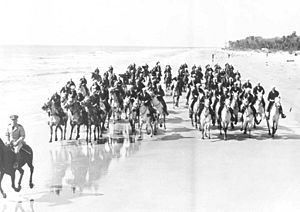
An experimental steam cannon guarding Port Royal Sound was built around 1900, in what is now Port Royal Plantation. The cannon was fixed but its propulsion system allowed for long range shots for the time.
In 1931, Wall Street tycoon, physicist, and patron of scientific research Alfred Lee Loomis, along with his brother-in-law and partner Landon K. Thorne, purchased 17,000 acres (69 km2) on the island (over 63% of the total land mass) for about $120,000 to be used as a private game reserve. On the Atlantic coast of the island, large concrete gun platforms were built to defend against a possible invasion by the Axis powers of World War II. Platforms like these can be found all along the Eastern Seaboard. The Mounted Beach Patrol and Dog Training Center on Hilton Head Island trained U.S. Coast Guard Beach Patrol personnel to use horses and dogs to protect the southeastern coastline of the U.S.
In the early 1950s, three lumber mills contributed to the logging of 19,000 acres (77 km2) of the island. The island population was only 300 residents. Prior to 1956, access to Hilton Head was limited to private boats and a state-operated ferry. The island's economy centered on shipbuilding, cotton, lumbering, and fishing.
The James F. Byrnes Bridge was built in 1956. It was a two-lane toll swing bridge constructed at a cost of $1.5 million that opened the island to automobile traffic from the mainland. The swing bridge was hit by a barge in 1974 which shut down all vehicle traffic to the island until the Army Corps of Engineers built and manned a pontoon bridge while the bridge was being repaired. The swing bridge was replaced by the current four-lane bridge in 1982.
The beginning of Hilton Head as a resort started in 1956 with Charles E. Fraser developing Sea Pines Resort. Soon, other developments followed, such as Hilton Head Plantation, Palmetto Dunes Plantation, Shipyard Plantation, and Port Royal Plantation, imitating Sea Pines' architecture and landscape. Sea Pines however continued to stand out by creating a unique locality within the plantation called Harbour Town, anchored by a recognizable lighthouse. Fraser was a committed environmentalist who changed the whole configuration of the marina at Harbour Town to save an ancient live oak. It came to be known as the Liberty Oak, known to generations of children who watched singer and songwriter Gregg Russell perform under the tree for over 25 years. Fraser was buried next to the tree when he died in 2002.
The Heritage Golf Classic was first played in Sea Pines Resort in 1969 and has been a regular stop on the PGA Tour ever since. Also in 1969, the Hilton Head Island Community Association successfully fought off the development of a BASF chemical complex on the shores of Victoria Bluff (now Colleton River Plantation). Soon after, the association and other concerned citizens "south of the Broad" fought the development of off-shore oil platforms by Brown & Root (a division of Halliburton) and ten-story tall liquefied natural gas shipping spheres by Chicago Bridge & Iron. These events helped to polarize the community, and the Chamber of Commerce started drumming up support for the town to incorporate as a municipality. After the Four Seasons Resort (now Hilton Head Resort) was built along William Hilton Parkway, a referendum of incorporation was passed in May 1983. Hilton Head Island had become a town.
The Land Management Ordinance was passed by the Town Council in 1987. Disney's Hilton Head Island Resort opened in 1996, and the Cross Island Parkway opened in January 1997. An indoor smoking ban in bars, restaurants, and public places took effect on May 1, 2007.
Fort Howell, Cherry Hill School, Daufuskie Island Historic District, Fish Haul Archaeological Site (38BU805), Green's Shell Enclosure, Hilton Head Range Rear Light, Sea Pines, Skull Creek, SS William Lawrence Shipwreck Site, and Stoney-Baynard Plantation are listed on the National Register of Historic Places.
Geography
Topography
Hilton Head Island is a shoe-shaped island that lies 20 miles (32 km) by air northeast of Savannah, Georgia, and 90 miles (140 km) south of Charleston.
According to the United States Census Bureau, the town has a total area of 69.2 square miles (179.1 km2), of which 41.4 square miles (107.1 km2) is land, and 27.8 square miles (71.9 km2), or 40.17%, is water.
Barrier island
Hilton Head Island is sometimes referred to as the second largest barrier island on the Eastern Seaboard after Long Island (which is not actually a barrier island but two glacial moraines). Technically, however, Hilton Head Island is only a half barrier island. The north end of the island is a sea island dating to the Pleistocene epoch, and the south end is a barrier island that appeared as recently as the Holocene epoch. Broad Creek, which is actually a land-locked tidal marsh, separates the two halves of the island.
The terrain of a barrier island is determined by a dynamic beach system with offshore bars, pounding surf, and shifting beaches; as well as grassy dunes behind the beach, maritime forests with wetlands in the interiors, and salt or tidal marshes on the lee side, facing the mainland. A typical barrier island has a headland, a beach and surf zone, and a sand spit.
Gated communities
- Hilton Head Plantation
- Indigo Run Plantation
- Long Cove Plantation
- Palmetto Hall Plantation
- Port Royal Plantation
- Sea Pines Resort
- Shipyard Plantation
- Spanish Pointe
- Spanish Wells plantation
- Wexford Plantation
- Windmill Harbour
- Victoria Square
- Ashton Cove
- Bermuda Pointe
- Yacht Cove
- Palmetto Dunes Oceanfront Resort
Wildlife
The Hilton Head Island area is home to a vast array of wildlife, including alligators, deer, loggerhead sea turtles, manatees, hundreds of species of birds, and dolphins.
The Coastal Discovery Museum, in conjunction with the South Carolina Department of Natural Resources, patrols the beaches from May through October as part of the Sea Turtle Protection Project. The purpose of the project is to inventory and monitor nesting locations, and if necessary, move them to more suitable locations. During the summer months, the museum sponsors the Turtle Talk & Walk, which is a special tour designed to educate the public about this endangered species. To protect loggerhead sea turtles, a town ordinance stipulates that artificial lighting must be shielded so that it cannot be seen from the beach, or it must be turned off by 10:00 p.m. from May 1 to October 31 each year. The waters around Hilton Head Island are one of the few places on Earth where dolphins routinely use a technique called "strand feeding", whereby schools of fish are herded up onto mud banks, and the dolphins lie on their side while they feed before sliding back down into the water.
Particularly prominent in the ocean waters surrounding Hilton Head Island, the stingray serves as a fascination and painful natural encounter for many beach goers. Small stingrays inhabit the quieter, shallow region of ocean floor just beyond the break of the surf, typically buried beneath a thin layer of sand. Stingrays are a type of demersal, cartilaginous fish common to the South Carolina coast as well as other areas on the Atlantic shoreline. Typically, stingrays avoid contact with humans unless they are accidentally stepped upon, a situation often ending in a stingray injury, where the stingray punctures the human with its poisonous barb. While these injuries are extremely painful, they are not usually life-threatening as long as they are properly attended to by a medical professional. One complaint shared by many Hilton Head Island tourists is that the lifeguards maintain a poor alert system for notifying swimmers when numerous stingrays have been sighted within a specific stretch of the shore. This lack of notification on days when multiple sightings are reported can sometimes end in a high number of stingray injuries that might have otherwise been avoided; in 2009, 121 people were treated for stingray injuries.
The saltmarsh estuaries of Hilton Head Island are the feeding grounds, breeding grounds, and nurseries for many saltwater species of game fish, sport fish, and marine mammals. The dense plankton population gives the coastal water its murky brown-green coloration.
Plankton support marine life including oysters, shrimp and other invertebrates, and bait-fish species including menhaden and mullet, which in turn support larger fish and mammal species that populate the local waterways. Popular sport fish in the Hilton Head Island area include the red drum (or spot tail bass), spotted sea trout, sheepshead, cobia, tarpon, and various shark species.
Climate
Hilton Head Island has a humid subtropical climate.
| Climate data for Hilton Head Island, South Carolina | |||||||||||||
|---|---|---|---|---|---|---|---|---|---|---|---|---|---|
| Month | Jan | Feb | Mar | Apr | May | Jun | Jul | Aug | Sep | Oct | Nov | Dec | Year |
| Average high °F (°C) | 61 (16) |
63 (17) |
69 (21) |
71 (22) |
82 (28) |
87 (31) |
90 (32) |
88 (31) |
85 (29) |
78 (26) |
70 (21) |
63 (17) |
76 (24) |
| Average low °F (°C) | 38 (3) |
40 (4) |
47 (8) |
54 (12) |
62 (17) |
69 (21) |
72 (22) |
71 (22) |
68 (20) |
57 (14) |
48 (9) |
41 (5) |
56 (13) |
| Average precipitation inches (mm) | 3.7 (94) |
3.5 (89) |
3.9 (99) |
3.0 (76) |
3.6 (91) |
5.3 (130) |
6.2 (160) |
8.9 (230) |
5.1 (130) |
2.6 (66) |
2.4 (61) |
3.2 (81) |
51.4 (1,310) |
| Source: Weatherbase | |||||||||||||
Demographics
| Historical population | |||
|---|---|---|---|
| Census | Pop. | %± | |
| 1990 | 23,694 | — | |
| 2000 | 33,862 | 42.9% | |
| 2010 | 37,099 | 9.6% | |
| 2019 (est.) | 39,861 | 7.4% | |
| U.S. Decennial Census[1] | |||
2020 census
| Race | Num. | Perc. |
|---|---|---|
| White (non-Hispanic) | 29,150 | 77.4% |
| Black or African American (non-Hispanic) | 2,160 | 5.74% |
| Native American | 46 | 0.12% |
| Asian | 286 | 0.76% |
| Pacific Islander | 5 | 0.01% |
| Other/Mixed | 969 | 2.57% |
| Hispanic or Latino | 5,045 | 13.4% |
As of the 2020 United States census, there were 37,661 people, 17,513 households, and 11,692 families residing in the town.
2010 census
As of the census of 2010, there were 37,099 people, 16,535 households, and 10,700 families residing in the town, occupying a land area of 42.06 square miles (109 km2). The population density was 882.0 people per square mile (340.4/km2). There were 33,602 housing units at an average density of 798.9 per square mile (308.3/km2).
Although the town occupies most of the land area of the island, it is not coterminous with it; there is a small part near the main access road from the mainland, William Hilton Parkway, which is not incorporated into the town. Hilton Head (the island) therefore has a slightly higher population (48,407 in Census 2000, defined as the Hilton Head Island Urban Cluster) and a larger land area (42.65 sq mi or 110.5 km2) than the town. The Hilton Head Island-Bluffton Beaufort Metropolitan Statistical Area, which includes Beaufort and Jasper counties, had a 2012 estimated year-round population of 193,882.
The racial makeup of the town was 82.9% White, 7.5% African American, 0.2% Native American, 0.9% Asian, 0.1% Pacific Islander, 7.3% from other races, and 1.2% from two or more races. Hispanic or Latino of any race were 15.8% of the population.
Of the 16,535 households, 18.4% had children under the age of 18 living with them, 54.7% were married couples living together, 6.8% had a female householder with no husband present, and 35.3% were non-families. 28.3% of all households were made up of individuals, and 14.0% had someone living alone who was 65 years of age or older. The average household size was 2.23 and the average family size was 2.66.
In the town, the population was spread out, with 18% under the age of 20, 4.4% from 20 to 24, 20.4% from 25 to 44, 28.4% from 45 to 64, and 28.8% who were 65 years of age or older. The median age was 50.9 years. For every 100 females, there were 103.8 males. For every 100 females age 18 and over, there were 105.5 males.
According to a 2014 estimate, the median income for a household in the town was $68,437, and the median income for a family was $85,296. Males had a median income of $51,463 versus $36,743 for females. The per capita income for the town was $45,116. About 5.4% of families and 9.3% of the population were below the poverty line, including 16.9% of those under age 18 and 3.9% of those age 65 or over.
Ancestry/Ethnicity
The largest self-identified ancestry/ethnic groups on Hilton Head Island as of 2020 are:
| Largest ancestries (2020) | Percent |
|---|---|
| English | 47.5% |
| Irish | 10.1% |
| German | 2.2% |
| Italian | 2.1% |
| "American" | 1.9% |
| Greek | 1.3% |
| Scots-Irish | 0.9% |
| French (except Basque) | 0.7% |
Arts and culture
Organizations
- Formerly the Self Family Arts Center, the "Arts Center of Coastal Carolina" is a showcase for professional performing and visual arts, as well as cultural festivals and educational outreach. The Arts Center also offers community education, including Visual and Performing Arts Camps, Theater Camp, and other workshops and classes.
- The "Coastal Discovery Museum", located at 70 Honey Horn Drive, offers a variety of programs, activities, and indoor and outdoor exhibits year-round to over 125,000 visitors. The Discovery House has permanent exhibitions about the natural history and cultural heritage of the Lowcountry, a gift store, Kids' Zone and a temporary gallery space. The museum offers many tours of its 68-acre (28 ha) property that includes salt marsh boardwalks, trails, a native butterfly habitat and various gardens. The Coastal Discovery Museum is open Monday — Saturday, 9:00 a.m. – 4:30 p.m. and Sunday 11:00 a.m. – 3:00 p.m.
- The "Hilton Head Choral Society", founded in 1975, is a non-profit organization "open to community members who love to sing and enjoy good fellowship." The choirs of the Hilton Head Choral Society are known for their diverse musical repertoire including classical masterworks, pops concerts and lighter fare, patriotic and Americana, and gospel and musical theatre. There is also a 20-voice chamber choir and a youth choir. The 120-member full chorus presents four major programs per season: A Fall Pops Concert, The Christmas Concert, The Musical Masterworks Concert and a pair of Memorial Day concerts celebrating the art of American choral singing and a patriotic tribute.
- The "Hilton Head Symphony Orchestra" was started 25 years ago by a handful of musicians and classical music aficionados who dreamed of bringing "big city" culture to Hilton Head. Since then, they have transformed from a small group of classical music lovers to a highly rated symphony orchestra. Their main performance hall is the First Presbyterian Church on William Hilton Parkway, next to Fire Station 3. A branch formed from the Hilton Head Symphony Orchestra is the Hilton Head Youth Orchestra, helping young musicians across the county with their love for music.
- The "Arts Council of Beaufort County" (ACBC)'s mission is to promote and foster the arts of Beaufort County, including Hilton Head Island. ACBC's vision is to position and maintain Beaufort County as a vibrant arts community and destination through active marketing, service to current arts organizations and artists and advocacy for the arts. ACBC programs include Quarterly Community Arts Grants, the Ever Expanding Arts Calendar, Get Your Art Out emerging artist initiative, the print publication ArtNews, and Arts of the Roundtables, which are free quarterly seminars exploring the business of art.
- The "Main Street Youth Theatre", located on the north end of the island on Main Street, is a non-profit community theatre dedicated to enriching the lives of the island's youth by providing a true theatrical experience. Each year, MSYT performs four or five Broadway-quality shows that run about two months at a time. During the tourist season, MSYT is a major tourist attraction and is also a local hot spot year round. The organization also provides acting, dance, and vocal instruction after school and during the summer.
- "Lifelong Learning of Hilton Head Island" offers the adult community of Hilton Head Island a collection of educational and fun classes covering subjects from history, arts, yoga, and current events to outer space exploration and beyond. Each semester promises choices from 20–30 topics. Annual membership is $30. Fall and Winter terms are $45 each with no limit on the number of classes a member can take.
- "The Heritage Library of Hilton Head Island" is the repository for Hilton Head Island history and a premier ancestry research center. The Heritage Library is a non-profit member library that is open to the public for a small daily fee, and offers history programs, genealogy classes, and special programs throughout the year.
Annual events
- Gullah Celebration – Although threatened by the rapid increase in tourism, Gullah culture can be seen at the annual Hilton Head Island Gullah Celebration which is held at Shelter Cove Community Park in February. In the summer, the acclaimed Hallelujah Singers present a Gullah concert series at Hilton Head's Arts Center of Coastal Carolina.
- WineFest – The Annual WineFest is the largest outdoor, tented wine tasting on the East Coast, featuring over 1,500 domestic and international wines.
- St. Patrick's Day Parade – The annual St. Patrick's Day Parade draws over 20,000 people.
- WingFest – The annual Hargray WingFest is held at Shelter Cove Community Park. The event is operated by the Island Recreation Association, and all proceeds benefit the Island Recreation Scholarship Fund.
- HarbourFest – HarbourFest, now in its 26th season, is held every Tuesday night from June to August at Shelter Cove Marina. It features arts and crafts, live entertainment, and fireworks at sunset. There is a special HarbourFest celebration on July 4.
- Heritage Golf Classic – The annual Heritage Classic Golf Tournament is held every April at Harbour Town Golf Links in Sea Pines Resort.
- Rib Burnoff and Barbecue Fest – The annual Rib Burnoff & Barbecue Fest is held at Honey Horn Plantation.
- Celebrity Golf Tournament – The annual Celebrity Golf Tournament is held at the Golf Club at Indigo Run, the Robert Trent Jones course in Palmetto Dunes and Harbour Town Golf Links. The tournament has contributed over $3 million to 18 children's charities.
- FoodFest – FoodFest celebrates the talent of the local hospitality industry and provides attendees with several spectator events including: The Best Bartender Drink Making Contest, The Hospitable Waiter’s Race, and The Tailgate Gourmet Challenge.
- Chili Cookoff – The annual Chili Cookoff is held at Honey Horn Plantation.
- Community Festival – The annual Community Festival at Honey Horn Plantation features a "haunted trail" in the "haunted forest" presented by the Hilton Head Rotary Club and the Interact Clubs from Hilton Head Island High School and Hilton Head Preparatory School.
- Motoring Festival and Concours d'Elegance – World-class automobiles take center stage each November at the annual Hilton Head Island Motoring Festival & Concours d'Elegance at the Honey Horn Plantation. The festival features some of the country's finest collector automobiles, including classic cars, two-wheeled machines, wooden boats, and beach mobiles.
- The Dove Street Festival of Lights – Begun 1990, the Dove Street Festival of Lights takes place each December. It began when a local family on the street adopted their daughter and wanted to dedicate an event to her. Local families on Dove street decorated the entire street with holiday lights, connecting the homes together to create a light tunnel effect. Previously, the Glee Club of the Miami University of Ohio serenaded residents with holiday songs. Town volunteers collect donations of money, food and toys at the festival that are given to The Deep Well Project, a local charity. In recent years the festival has moved from the original Dove Street to Shelter Cove Lane where the town can assist in the electrical costs.
Parks and recreation
Public beach access
- Alder Lane Beach Access – 22 metered spaces
- Burkes Beach Access – 13 metered spaces
- Coligny Beach Park — parking is free — some parking reserved for annual beach passes from 8:00 a.m. to 3:00 p.m.
- Driessen Beach Park – 207 long term parking spaces — some parking reserved for annual beach passes from 8:00 a.m. to 3:00 p.m.
- Fish Haul Park — parking is free
- Folly Field Beach Park – 51 metered spaces
- Islanders Beach Park — annual beach pass parking only
- Mitchelville Beach Park — parking is free
Island parks
- Alder Lane Beach Access
- Barker Field
- Burkes Beach Access
- Broad Creek Boat Ramp
- Chaplin Community Park
- Coligny Beach Park
- Compass Rose Park
- Cordillo Tennis Courts
- Crossings Park & Bristol Sports Arena
- Driessen Beach Park
- Fish Haul Creek Park
- Folly Field Beach Park
- Green Shell Park
- Hilton Head Park (Old Schoolhouse Park)
- Islanders Beach Park
- Jarvis Creek Park
- Marshland Road Boat Landing
- Old House Creek Dock
- Shelter Cove Community Park
- Xeriscape Garden
In popular culture
In the popular television series A Different World, Whitley Gilbert's parents have a summer home there.
In "Big Trouble in Little Langley", a 2007 episode of American Dad!, Francine's birth parents Nick and Cassandra Dawson live there.
In the book By Order of the President, by W. E. B. Griffin, the President of the United States maintains a home on Hilton Head Island. This is where Charlie Castillo meets the President for the first time.
In the 2012 movie Parental Guidance (starring Billy Crystal, Bette Midler, and Marisa Tomei), the parents visit Hilton Head Island for a conference. Aerial pans of Harbor Town are shown.
In the science fiction franchise BattleTech, the headquarters of the interstellar telecommunications organization "ComStar" are located on Hilton Head Island.
Economy
According to Hilton Head Island's 2017 Comprehensive Annual Financial Report, the top employers in the town are:
| # | Employer | # of Employees |
|---|---|---|
| 1 | Serg Group Restaurants | 869 |
| 2 | Sea Pines Resort | 672 |
| 3 | Hilton Head Medical Center | 558 |
| 4 | Beaufort County School District | 518 |
| 5 | Marriott Vacation Club | 463 |
| 6 | Salty Dog | 388 |
| 7 | Cypress of Hilton Head | 352 |
| 8 | Westin Hotels & Resorts | 266 |
| 9 | Omni Hilton Head Resort | 300 |
| 10 | Sonesta Resort Hilton Head | 280 |
Education
Schools
Public schools
- Hilton Head Island Early Childhood Center (Pre K — K)
- Hilton Head Island School for the Creative Arts (Grades 1–5)
- Hilton Head Island International Baccalaureate Elementary School (Grades 1–5)
- Hilton Head Island Middle School
- Hilton Head Island High School
Private schools
- Hilton Head Preparatory School
- Hilton Head Christian Academy
- St. Francis Catholic School
- Heritage Academy
- Sea Pines Montessori Academy
- The Island Academy of Hilton Head
Library
Hilton Head has a public library, a branch of the Beaufort County Library.
Infrastructure
Airport
Hilton Head Island is served by the Hilton Head Airport which is owned by Beaufort County. American Airlines, Delta Air Lines, and United Airlines serves the airport. In the first half of 2019, the airport saw a 225% increase in passengers arriving and departing, when compared with the same time period one year prior. This was attributed to new air service and added seat capacity, made possible by the airport's 2018 runway expansion.
Emergency services
Hilton Head Island Fire & Rescue began operations July 1, 1993, as a consolidation of the former Sea Pines Forest Beach Fire Department, the Hilton Head Island Fire District, and the Hilton Head Island Rescue Squad. There are seven fire stations on Hilton Head Island.
Police services are contracted through Beaufort County Sheriff's Office. The island is equipped with an enhanced 9-1-1 system.
Public transportation
Hilton Head Island is served seasonally by The Breeze public trolley service which is provided by the Lowcountry Regional Transit Authority.
Notable people
- Arthur Blank: owner NFL Atlanta Falcons and Home Depot, has a house in Sea Pines Resort
- William P. Clyde: owner and president of the Clyde Steamship Company
- Cranford Hollow: alternative country and rock band
- Bobby Cremins: former NCAA men's basketball coach, currently resides in Charleston, but maintains a home in Hilton Head
- Wilbur Cross: author
- Dan Driessen: former Major League Baseball player; Cincinnati Reds and others
- Jim Ferree: golfer on PGA Tour and Senior PGA Tour
- Trevor Hall: reggae/folk rock singer-songwriter on Now 40, was raised in Hilton Head
- Ryan Hartman: professional hockey player
- Darrell Hedric: former head basketball coach at Miami University (Ohio), former NBA scout
- John Jakes: author of historical fiction like North and South (set in Charleston), resides in Hilton Head, a NY Times Best Selling Author
- Michael Jordan: former NBA player, had a house on Hilton Head from 1988 to 1999
- John V. Lindsay: former mayor of New York City, died in Hilton Head on December 19, 2000
- John Mellencamp: Rock and Roll Hall of Fame singer-songwriter from Bloomington, Indiana; did #1 song "Jack and Diane" in 1982
- Mark Messier: Canadian former NHL hockey player, part-time resident of Hilton Head
- Garry Moore: television variety-show and game-show host
- Gregg Russell: children's singer, performed under the old oak tree in Harbour Town since 1976
- Serge Savard: former Montreal Canadiens defenseman and general manager|ref
- Duncan Sheik: singer-songwriter of the 1997 Grammy-nominated song "Barely Breathing", writer of the hit Broadway show Spring Awakening, was raised in Hilton Head
- Stan Smith: tennis pro, 1972 Wimbledon, 1971 US Open and Davis Cup champion
- Col. Benjamin H. Vandervoort: WWII hero, died in his home on Hilton Head in 1990 at the age of 75
- Kathryn R. Wall: author of mystery novels
- Lois Rhame West: First Lady of South Carolina (1971–1975), first woman to chair the Muscular Dystrophy Association
- Jayson Williams: former NBA basketball player, owns a home on Hilton Head
Images for kids
-
Mitchelville "refugee quarters", 1864
See also
 In Spanish: Hilton Head Island para niños
In Spanish: Hilton Head Island para niños





